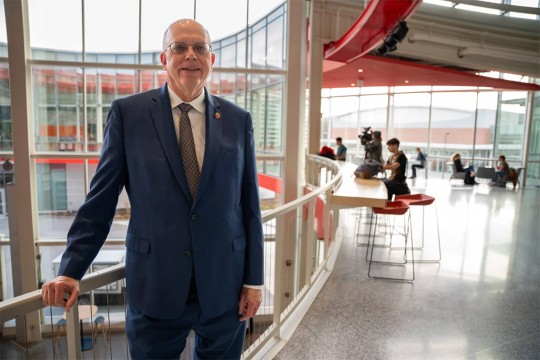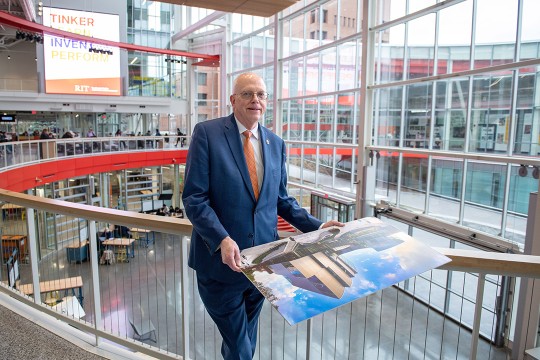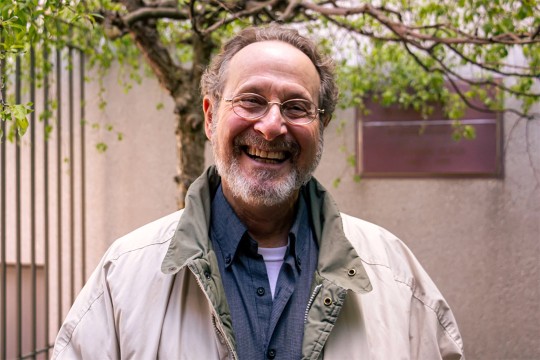Carl Chiarenza ’57: In the abstract
“I never felt quite at home with that,” he says. Even in his early photos, Chiarenza would aim his lens in such a way that rocks, doors and plants, for instance, would be transformed into compositions of pattern, texture and tone. “The abstraction was always there,” he says. Realizing that all photography is essentially abstract, he left realism completely behind by 1960.
In 1979, he discovered the subject matter that has occupied him ever since. He began photographing collages he assembles in the studio out of assorted materials including metal scraps, foil, bits of paper, lids from tin cans and such.
“After that, I never made another picture outdoors – or indoors, except for the collages.”
The critically acclaimed black-and-white images have been displayed in more than 80 one-person shows and more than 250 group exhibitions. The sixth book of his photos, Pictures Come From Pictures, Selected Photographs 1955-2007 (David R. Godine Publisher), was published in September 2008. Chiarenza’s photos are in the collections of important museums worldwide including the National Museum of American Art (Washington, D.C.), Philadelphia Museum of Art, Museum of Modern Art (New York City), Art Institute of Chicago, Museum of Fine Arts (Boston), The Getty Museum (Los Angeles), George Eastman House (Rochester), Museum of Art (St. Petersburg), Bibliotheque Nationale de France (Paris), Art Gallery of Ontario (Canada), and Kiyosato Museum of Photographic Arts (Japan). A 5-by-14-foot quartet of his photos is permanently displayed in the lobby of RIT’s Gannett Building.
His work as an artist parallels another distinguished career: Chiarenza taught art and art history for more than 35 years at Boston University and the University of Rochester, where he is now artist-in-residence and Fanny Knapp Allen Professor Emeritus of Art History.
When he entered RIT, he could not have predicted such a life.
“I was born on North Goodman Street (Rochester). We were poor. I went to RIT because it was inexpensive, and it was here,” he says. He had been interested in photography since childhood, and RIT’s photo program offered the means to a job, probably at Kodak.
“I wanted to be an artist, but it seemed there was no way to be an artist and make a living using photography,” he says.
The atmosphere at RIT’s photo department, with a faculty that included Ralph Hattersley, Minor White, Charles Arnold, Beaumont Newhall and others (plus Robert Koch teaching literature and creative writing), was “extraordinarily creative,” Chiarenza says.
“Our class, after the first two years, was a very small group,” he recalls. “There were only 14 of us. We were quite aware that something different was happening. Ralph Hattersley and Minor White pulled to opposite poles. Both used this medium of photography to express ideas, but they were very different. As you can imagine, there were a lot of discussions, not to say jokes. The mixture was just explosive. It certainly shook us up.”
After RIT, Chiarenza went to Boston University with the idea of becoming a photojournalist. He received an M.S. in 1959 and was promptly drafted into the Army. Just as he was about to get out two years later, President Kennedy froze all discharges. As a way of securing his release from the military, Chiarenza applied for and received a scholarship to study art history at Boston University.
“I didn’t plan to become an art historian, but I ended up teaching in the art history department. Even now, I can’t tell you how it happened but it was just perfect.”
Teaching allowed Chiarenza to pursue his work as an artist, and being a working artist enriched his teaching. “It takes two different kinds of minds,” he says. “There are art historians who are artists, but they are few and far between.”
At Boston University, he taught the first course in the history of photography ever offered in an art history department, and opened a gallery where he presented the work of noted contemporary photographers including Minor White, Paul Caponigro and Nathan Lyons.
He went on to earn a Ph.D. from Harvard in 1973, where he did his thesis on American abstract photographer Aaron Siskind, whom he had met on an RIT fi eld trip to the Institute of Design in Chicago. “It was the first dissertation ever done at Harvard on a living artist, let alone a photographer,” he says. He and Siskind became close friends, and the thesis ultimately became a book, Aaron Siskind: Pleasures and Terrors (Little Brown, 1982).
Chiarenza loved Boston but in 1986, the University of Rochester made an offer he found he couldn’t refuse. Plus, returning to his hometown gave him new opportunities to work with the George Eastman House and Visual Studies Workshop.
“I was pursued,” he says. “I succumbed.”
Now retired from full-time teaching, Chiarenza continues making photos in the studio of his suburban Rochester home. He continues to work with film and makes traditional prints – dark, rich, mysterious images typically ranging from about 11-by- 14 inches to 36-by-48 inches.
The collages themselves are surprisingly small – about 4-by-5 inches – and they only exist until Chiarenza has a photo that satisfies him. Using a Polaroid MP4 copy stand and camera, he moves the bits and pieces around, makes test prints, changes the lighting, exposes again. The process of transforming the scraps into rich, cohesive works of art can continue for days or even weeks.
“It’s chance and discovery and accident,” he says. “The work comes out of the materials and the light. They show me what to do.”
New ideas continue to come, even after 30 years. He developed a series called Peace Warriors in 2003, responding to the Iraq War. That was followed by Solitudes a year later.
He continues to work. The possibilities, it seems, are endless.
Chiarenza's work is on display until April 19, 2009, at Image City Photography Gallery, 722 University Ave., Rochester, N.Y. The "Master's Invitational" show also includes works by RIT photography professors Andrew Davidhazy '67 and John Retalleck '70, both RIT photo alumni.














